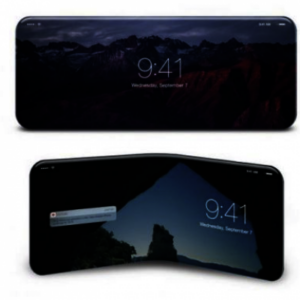In case you missed it, the new Google Pixel 4 and Pixel 4XL display specs were released last week with the DisplayMate Technology labs shoot out reaching yet another highest rating (A+ visually indistinguishable from perfect) for both the 5.7- and 6.3-inch P-OLED displays.

The point underscores the incremental improvement of the small OLED display space (i.e. the 10% higher peak brightness over the Pixel 3 along with improvements in “five key areas” like absolute color and contrast accuracy.) While these achievements are not trivial, like the NASA subsequent moon landings in the late 60’s and early 70’s, they’ve reached a “ho-hum” status looking for the next iconic (trip to Mars) breakthrough. Enter the age of foldable phones…
Looking at the track record of the foldable display one may conclude that making a trip to the red planet (Mars) would be an easier feat (and take far less time) than launching a commercially viable foldable display. However two milestones may actually portend the successful launch of “foldables” in the commercial space. First, the new Android 10 OS includes support for a mobile folding display, it is baked into the operating system. Add to this, the world’s largest smartphone supplier, that Samsung, will finally bring its Galaxy Fold to the US market (for a whopping $1980 price) after being still-born (yes the extended delay was display related-see note below). Look for details on its 7.3-inch (unfolded size) “Infinity Flex” display published last November.
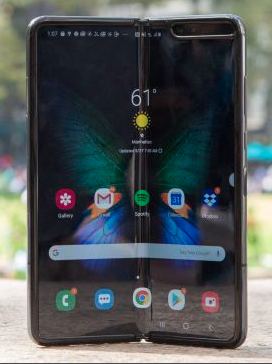 Galaxy fold long delayed launch will finally hit US market this month, Source Tom’s Guide.com
Galaxy fold long delayed launch will finally hit US market this month, Source Tom’s Guide.com
The other “big rocket” in the space, Apple, is on record as filing patents for its own brand of foldable display smartphone, and that story goes back over a year ago. In Oct of 2018, a Patently Apple announced the filing of a unique magnetic hinge design from Apple that looked as thought it was up to the level of the slick design of the Apple products of yesteryear. The company has not been know for leading smartphone innovation since the Bush (the younger) administration and resisted even the larger 6.5-inch display sizes until the launch of its generation 8 (iPhone XS Max). So, we don’t look to Apple for leadership in the coming foldable phone era, just leaks of cool-looking technology that a “bean-counter” leadership mentality will not allow to market. Perhaps that’s one reason former chief design officer, Sir Jonathan Paul Ive left Apple’s ranks.
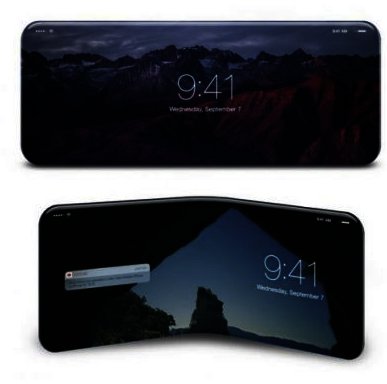 Prototype image of Apple patent foldable display cir. 2018. Source PatentlyApple.com
Prototype image of Apple patent foldable display cir. 2018. Source PatentlyApple.com
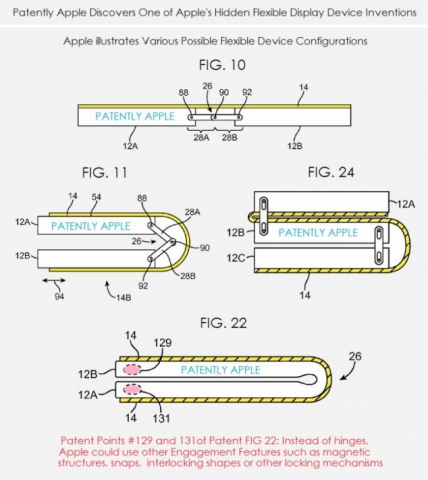 Other foldable smartphones on the horizon include the $2400 (17K yuan) Huawei Mate X clamshell folding phone which is due to launch in mid-November, exclusively in China. This is a Motorola Razr (remember?) The product concept includes use as an 8-inch diagonal tablet with two displays, front facing 6.6- and rear facing 6.4-inch displays. The Mate X had its launch delayed, as well, its Summer 2019 debut slipping to a November 15 launch date, again due to tricky folding display issues. Other brands include the Royal (Flexpad), Microsoft (Surface Duo), Motorola (Razr) and LG (G8 ThinQ).
Other foldable smartphones on the horizon include the $2400 (17K yuan) Huawei Mate X clamshell folding phone which is due to launch in mid-November, exclusively in China. This is a Motorola Razr (remember?) The product concept includes use as an 8-inch diagonal tablet with two displays, front facing 6.6- and rear facing 6.4-inch displays. The Mate X had its launch delayed, as well, its Summer 2019 debut slipping to a November 15 launch date, again due to tricky folding display issues. Other brands include the Royal (Flexpad), Microsoft (Surface Duo), Motorola (Razr) and LG (G8 ThinQ).
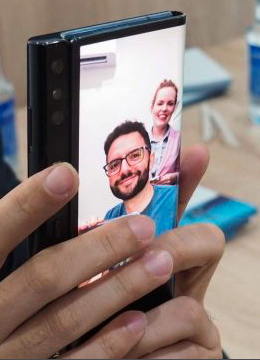 Huewei Mate X front / rear display fold, source Tom’s Guide.com
Huewei Mate X front / rear display fold, source Tom’s Guide.com
Suffice it to say, the foldable smartphones are here, overpriced, in the supply pipe line and looking for a breakout design that will set the standard for the next wave of in-hand technology to dominate the foreseeable future. This time next year perhaps all manufacturing bugs will be worked, out, prices have settled down to a sub-orbital altitude, and we may all be on-board, wondering how we ever got along with those outdated, flat displays for so long? Stephen Sechrist
Don’t miss the full Google Pixel 4 display shoot-out article from Display Mate Technologies.
Google Pixel 4 vs Pixel 3 incremental display specs
Pixel 4:
- 5.7 in (140 mm) FHD+
- 1080p P-OLED at 444 ppi, 2280×1080 pixel resolution (19:9)
- Corning Gorilla Glass 5 and a dynamic 90Hz refresh rate
Pixel 3:
- 5.5 in (140 mm) FHD+
- OLED at 443 ppi, 2160×1080 pixel resolution (2:1)
- Corning Gorilla Glass 5 and 424 nits max brightness
Pixel 4 XL:
- 6.3 in (160 mm) QHD+
- 1440p P-OLED at 537 ppi, 3040×1440 pixel resolution (19:9)
- Corning Gorilla Glass 5 and a dynamic 90Hz refresh rate
Pixel 3 XL:
- 6.3 in (160 mm) QHD+
- OLED at 523 ppi, 2960×1440 (18.5:9) pixel resolution
- Corning Gorilla Glass 5 and 424 nits max brightness
Note: the Samsung Galaxy fold was first shown publicly at a Samsung developers conference in Nov, 2018, with launch in Korea starting in February, 2019. The launch in China was to begin in April, 2019 but was delayed “indefinitely” until front display and hinge issues were properly addressed.
Samsung Galaxy Fold Now Available
[Infographic] Galaxy Fold: The Technology Behind a Whole New Smartphone Category
[Video] New Form Factor, New Rules: Watch the Galaxy Fold’s Folding Test
Foldable Dual-Screen Smartphone Launches in China, Coming to Europe Q1 2018

